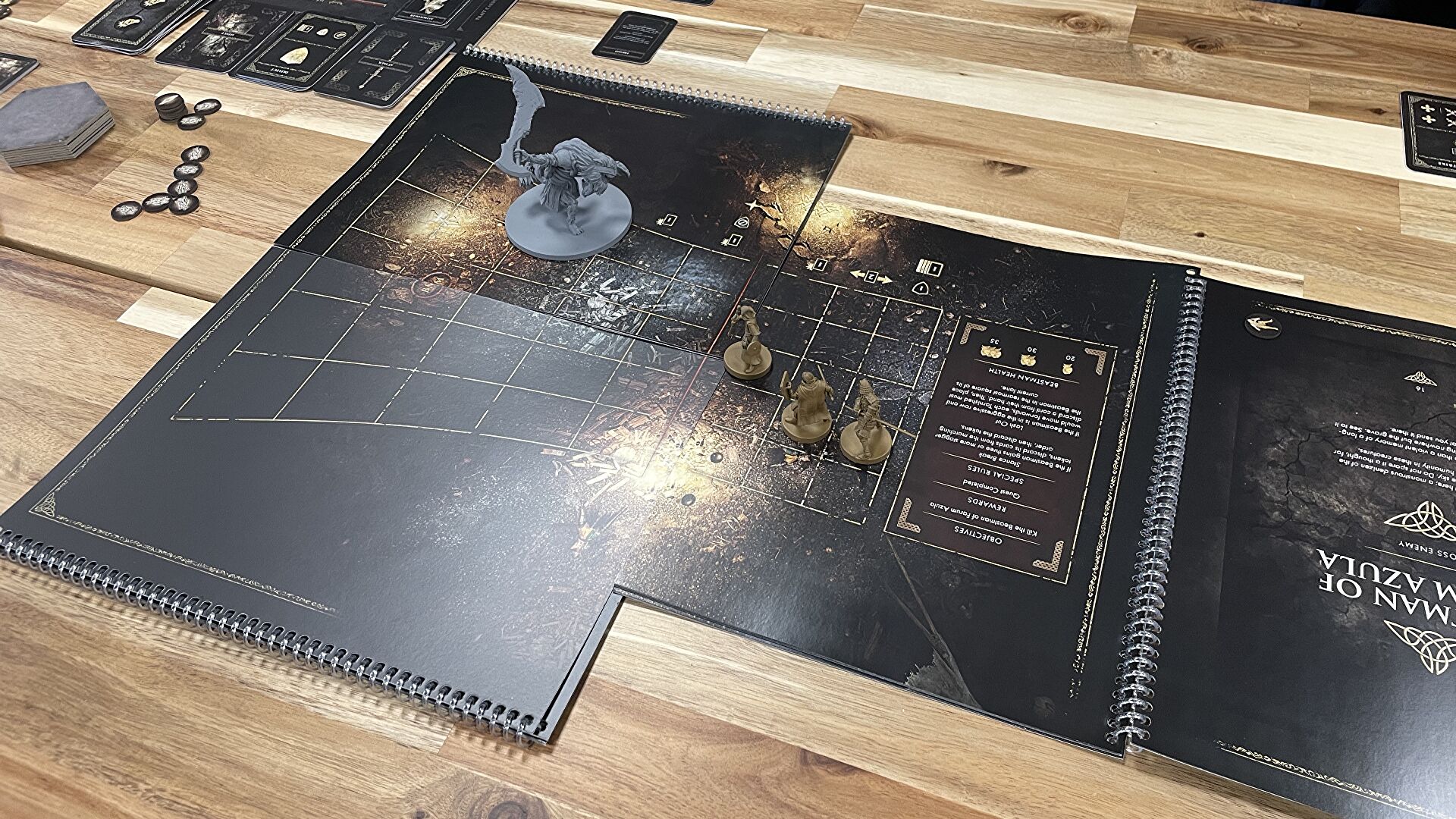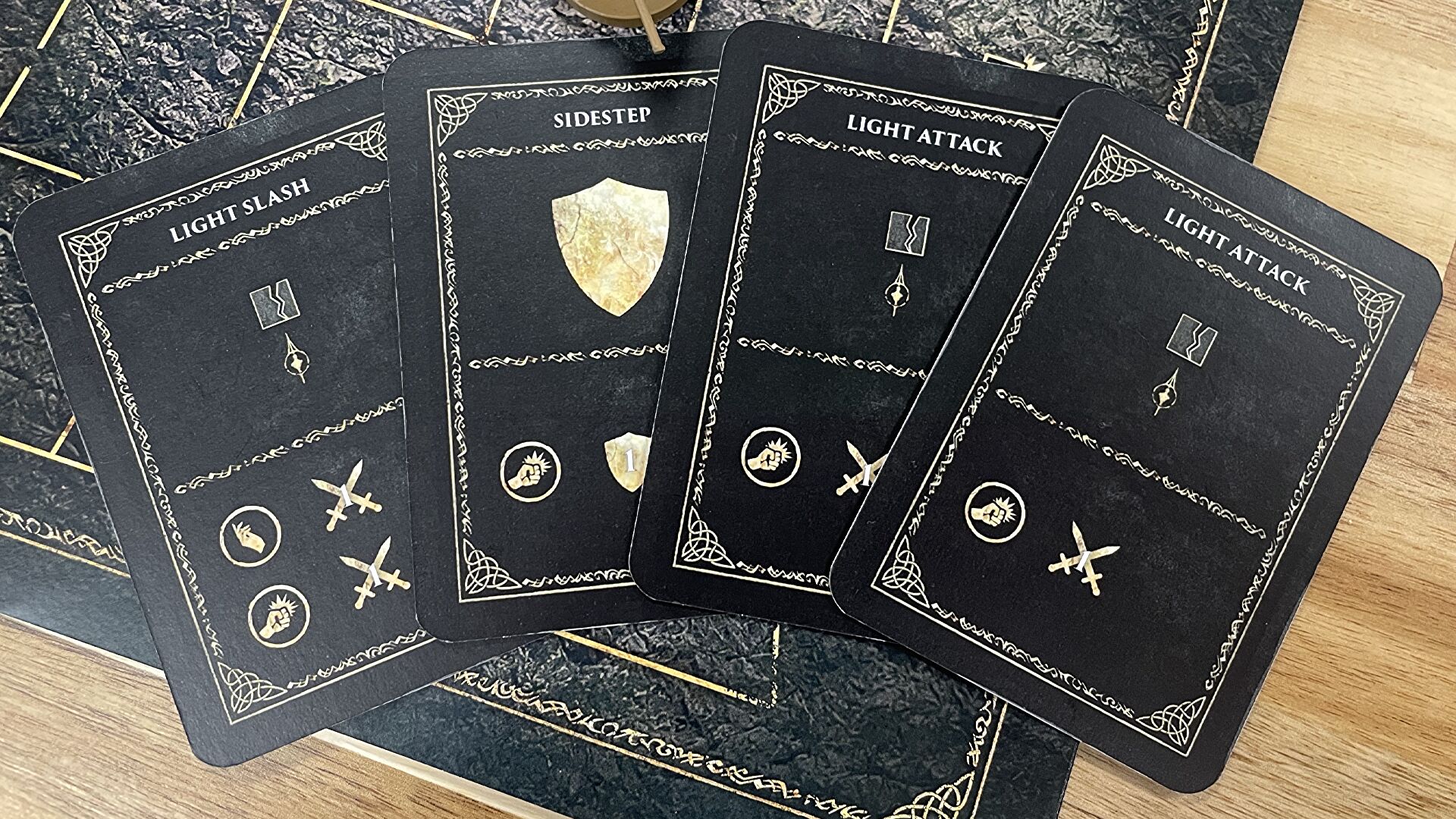Elden Ring: The Board Game looks to be as vast as its on-screen counterpart, spanning a number of upcoming standalone games and smaller expansions in order to cover the whole of the Lands Between. Players’ progress will carry across between each box (or they can jump in with a new, appropriately-levelled character), eventually forming a tabletop campaign matching Elden Ring’s story that Steamforged says will ultimately last over 100 hours. The first of those core releases will be Realm of the Grafted King. Despite being the size of a footstool and requiring you to stick down $179 during the game’s upcoming Kickstarter campaign, the enormous box will cover only the starting region of Limgrave, its roughly 20-plus-hour campaign culminating with a final fight against Margit, the Fell Omen at the gates of Stormveil Castle. (A separate expansion will delve into the castle itself and include an encounter with demigod boss Godrick the Grafted King himself.) Ahead of the board game’s crowdfunding campaign on November 22nd, Dicebreaker was able to play through a 90-minute preview of the upcoming game at Steamforged’s Manchester office. The demo we were shown focused on showcasing the exploration and combat gameplay of the board game, but gave more than enough time to get a good understanding of how each session will play - and realise that Elden Ring: The Board Game is much more than a direct adaptation of the video game to cardboard. That is only a good thing. Elden Ring: The Board Game is a game of two halves, separating out general exploration of the Lands Between before players dive into a climactic boss battle. More precisely, it’s a game of three thirds, with exploration estimated to take up an hour of each 90-minute session and the boss occupying the rest. The final foe and players’ goals for each session - dictated by a number of ‘Guidance of Grace’ objective cards - are determined by the quest they’re on. Like wandering between dungeons in the video game, these quests won’t be in a fixed order - instead, players can freely choose which they take on next (and swap to a different one if they find their current boss too tough) along a non-linear campaign. In the case of our tutorial demo, our party needed to hunt down a number of Stakes of Marika - which here add to a pool of shared lives for the group during the last fight - collect some resources and defeat some enemies out in the open world before we were able to confront the Beastman of Farum Azula in Limgrave’s Groveside Cave. In a stark contrast to the flawed Dark Souls: The Board Game, which buried its best moments between frustrating and exhausting grind, Elden Ring: TBG’s pre-boss prep is kept relievingly light. Each player gets three actions on their turn, with the choice to move, add a new hex tile to the board - gradually revealing the modular map - and interact with one of the various tokens that litter the Lands Between. These icons smartly reimagine the video game’s landmarks in cardboard form, from Effigies of the Martyr that can be used to summon your companions into battles (more on that in a moment) to map pillars that must be reached before a second stack of hex tiles can be placed. NPCs can also make an appearance, throwing up opportunities to trade with the merchants that occupy the Lands Between - for general goods or a secret that may help with the final fight - and pick up new quests from familiar faces. Yes, Patches is in here. Not every side quest you collect will be achievable in a single sitting, but these interactions carry over to future playthroughs by seeding cards into the deck, giving the impression of a world reacting to the players’ decisions and discoveries. Most of the interactions are similarly light - collect a token, draw a card, place a tile - keeping the turns flowing smoothly around the table. Get into a fight, though, and you start to see what makes Elden Ring: The Board Game really tick. A bit like watching the screen dissolve while traipsing through long grass in Pokémon, interacting with an enemy token pulls a player off of the map into a separate Quest Book of combat encounters, which play out across the spread of a ringbound tome used as a side board. (The player in combat continues to take their turns while the rest of the group keep exploring, so things don’t slow down.) One page gives you details on what you’re facing and your objective - which might be to simply kill everything, or one particular foe - while the other offers a gridded map depicting the battlefield. This battle grid abstracts the poise and timing of Soulsborne series’ on-screen combat. Rather than being a direct reflection of the player’s position to the enemy, the grid’s rows represent the different stances adopted by their character. It’s more akin to a turn-based RPG like Final Fantasy as characters switch between three rows on their side of the battlefield to adopt an aggressive, neutral or defensive stance. While the exact bonuses can change between encounters, staying upfront typically grants the chance to deal more damage at the risk of taking more in return, while turtling away at the back provides bonus defence and an extra card draw at the end of your turn. The middle row, meanwhile, offers the option to slide your card along the row of initiative cards randomly drawn to determine turn order, potentially letting you act before your opponent. It’s an intelligent way of boiling down the complex combination of timing windows, character position and poise into an analogue system that’s easy to understand at a glance, and demonstrates how Elden Ring’s move to the tabletop is a case of keeping faithful to its feel and vibe, rather than trying to turn code into cardboard. In motion, the decisions during combat feel difficult and tense, but your brainpower is focused squarely on what to do in the moment, not how to do it. Mechanical flexibility aside, this is still a Souls game, so there’s a whole host of weapons to experiment with and spec into your ideal character build. While each class - we used the nimble Samurai, with the Astrologer and Vagabond joining us - comes with a unique trait (in the case of the Samurai, the ability to move diagonally on the battle grid) and starting loadout, players will be able to build their character in whatever direction they like. This includes dropping points into specific stats - which influences how successful certain types of attack or defence will be during battles - acquiring trait cards with ongoing passive effects and equipping different gear. Each weapon determines the makeup of a deck of attack cards used by each player during fights. A katana might have more light slashes and movement, while a heavier greatsword will hit harder but leave less room for evasion. Magic, meanwhile, works in its own way, with the caster needing to build up focus points before unleashing a barrage of spells. It’s a tidy way of opening the doors to fairly deep customisation and progression over the course of Elden Ring: The Board Game’s campaign, without bolting on awkward rules and endless exceptions to its central combat system. Only a handful of cards are available to players on each turn, effectively doubling as a physical representation of their stamina bar; run out of cards, and you’ll need to spend actions to draw back up or risk being unable to attack, block or dodge. The open row of initiative cards declares what a boss is going to do, and when they’ll do it - a fun encapsulation of reading a boss’ animation patterns - but being too reckless or greedy with hits is, in true Soulslike fashion, a quick way back to the Site of Grace. Individual skirmishes with Godrick soldiers, knights and wolves out in the world are good fun, but Elden Ring: The Board Game knows why you’re here: the boss fights. It aims to make a spectacle out of finally finishing off your objectives and walking into a dungeon, and it succeeds. Where typical battles take place in a single player’s book, boss fights bring together the group’s books to Voltron into a much larger boss arena. It’s a striking effect, and a subtly effective way to allow the game’s designers to mix up the layout and terrain of standout fights without needing more than some extra pages in the same book. Bosses feel dangerous, their enlarged miniatures lumbering around the arena and - in the case of Beastman of Farum Azula - taking deadly sweeps across multiple squares that can quickly whittle away the party’s reserve of Stake of Marika tokens. The number of attacks per round scales to the number of players, providing a slick way of allowing a single player to run the gauntlet or a full party to step into the arena. Once a boss is finally felled - as we finally accomplished, albeit on our last life - the group retires back to the Roundtable Hold between missions, stocking up on items, crafting collected resources into new loot cards, spending runes to level their characters and upgrading weapons to add new cards to their attack card. After that, it’s back out into the Lands Between to seek their next foe. While our time with it so far is limited in the grand scheme of its ambitious campaign and sweeping world, Elden Ring: The Board Game so far seems to be shaping up to be the best kind of adaptation. The broad strokes are here as you recognise them from the video game - characters, places, items - but its creators have taken necessary liberty to make them work in a tabletop form. Exploration and combat keep the focus on what to do next on the table, rather than checking up on rules, while still managing to capture the feel of Soulsborne combat and discovery in their translation to a quest book, battle grid and map tiles. Whether Elden Ring: The Board Game will truly manage to capture the sense of discovery, mystery and challenge championed by the video game will become clear when the full board game hits tables in early 2024. What we’ve seen so far, though, bodes very well. Read Dicebreaker’s full preview of Elden Ring: The Board Game.



